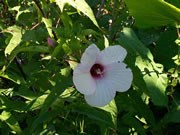
NPS photo Floodplains are primarily located along the shores of the Potomac and Shenandoah rivers, sometimes reaching inland along stream banks that drain into these rivers. Many forests on the lower floodplain are dominated by silver maple (Acer saccharinum), sycamore (Platanus occidentalis), and green ash (Fraxinus pennsylvanica). Upper floodplains are commonly covered with tulip poplar (Liriodendron tulipifera), sugar maple (Acer saccharum), hackberry (Celtis occidentalis), and white ash (Fraxinus americana). Shumard oak (Quercus shumardii) is one of the largest oaks, preferring moist, well-drained, bottomland soils on stream and riverbanks. |
Last updated: April 1, 2022
